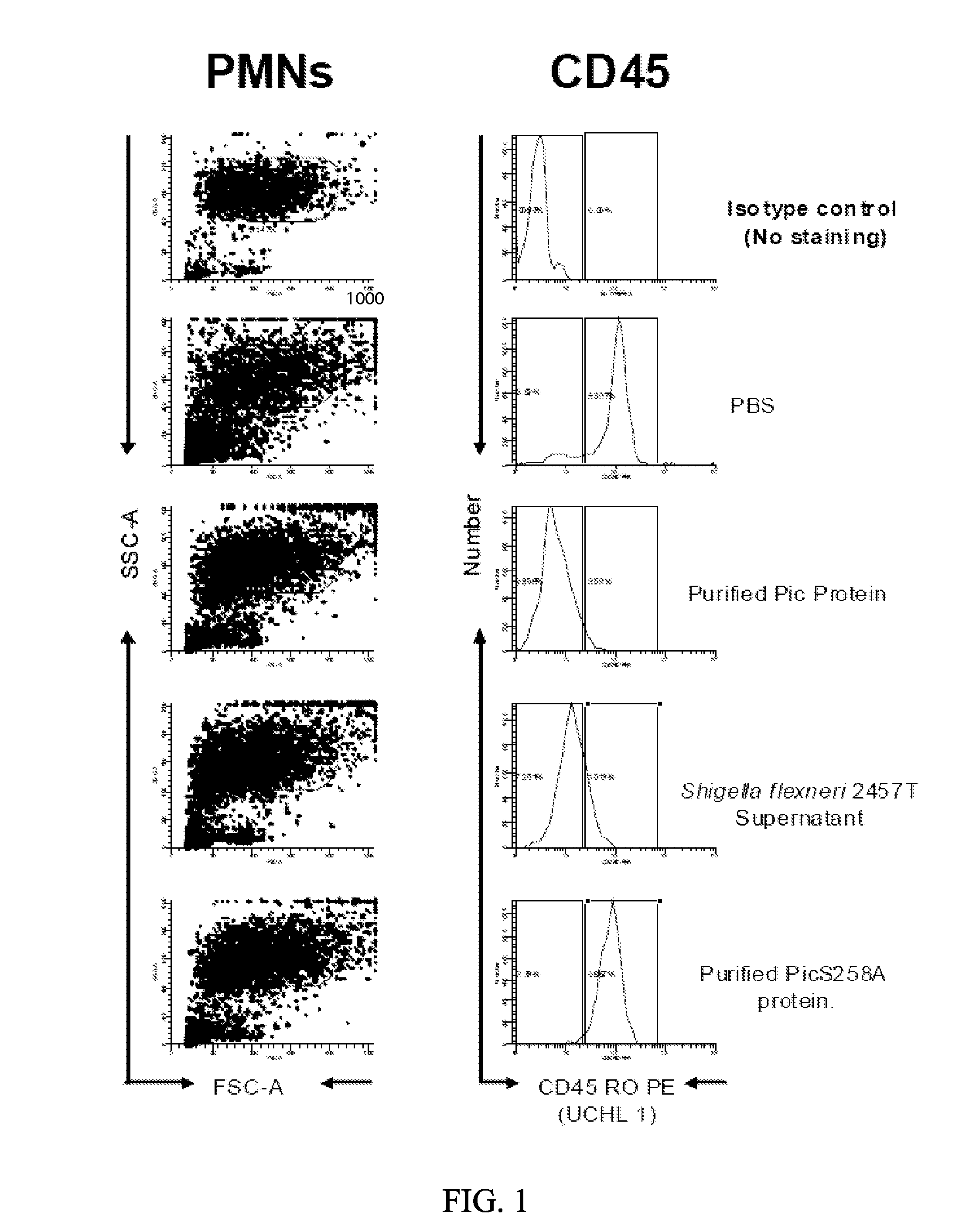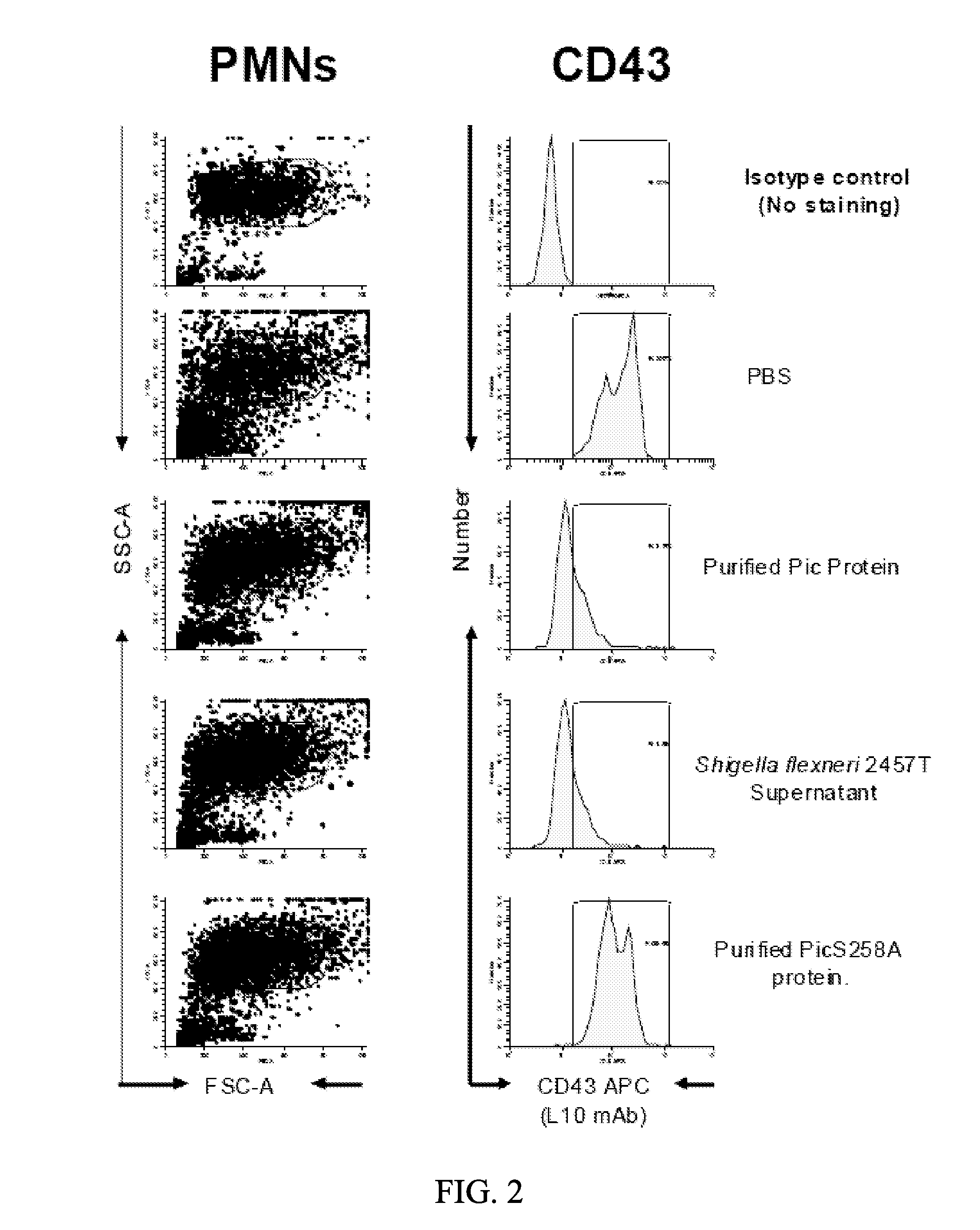Compositions and methods for treating inflammatory bowel disease and airway inflammation
a technology for inflammatory bowel disease and airway inflammation, which is applied in the direction of detergent compounding agents, peptide/protein ingredients, immunodeficiency disorders, etc., can solve the problems of increased risk of colon carcinoma in patients with ibd, increased risk of ibd and colon cancer, and unpredictable course, so as to reduce inflammation
- Summary
- Abstract
- Description
- Claims
- Application Information
AI Technical Summary
Benefits of technology
Problems solved by technology
Method used
Image
Examples
example 1
Pic Involvement in an Inflammatory Immune Response
[0085]The inventors have tested the activity of Pic in three forms: 1) purified from the supernatant of E. coli K12 expressing pPic; 2) from the crude supernatant of Shigella flexneri strain 2457T; and 3) in mutant form S258A, in which the catalytic serine is changed to the inactive alanine residue. Using these three forms, the inventors demonstrated that Pic cleaves particular proteins involved in a cellular inflammatory immune response, including, for example, CD43 (FIGS. 2, 3, and 6), CD45 (FIGS. 1 and 4), CD 162 (FIG. 5) on both lymphocytes and polymorphonuclear cells, whereas the S258A mutant is unable to cleave any of these proteins. The inventors demonstrate cleavage by treating purified lymphocytes and polymorphonuclear cells (PMNs), then lysing the cells and separating them by SDS-PAGE, followed by immunoblot with anti-CD43 or CD45 antibodies. These experiments demonstrated loss of CD43 on both cells types in the presence of...
example 2
[0086]Various models of IBD are used to determine whether or not a particular intervention is efficacious. IBD animal models can be divided into 5 different categories: (1) antigen-induced colitis and colitis induced by microbials; (2) other inducible forms of colitis (e.g., chemical, immunological, and physical); (3) genetic colitis models (e.g., transgenic and knock-out models); (4) adoptive transfer models, and (5) spontaneous colitis models. Such models and experimental designs are known in the art including, for example, DSS-induced colitis model, IL-10 knockout mouse, A20 knockout mouse, TNBS-induced colitis model, IL-2 knockout mouse, TCR-alpha receptor knockout mouse, and the E-cadherin knockout mouse (see, for example, US Patent Application Publication Nos. 20090312259; 20090312243; 20090311261; 20090311228; 20090306045; 20090274662; 20090263855; 20090263482; 20090214630; 20090209565; and 20070128303; and U.S. Pat. Nos. 7,625,876; 7,560,436; 7,538,...
example 3
[0091]Various models of airway inflammation are used to determine whether or not a particular intervention is efficacious. Such models and experimental designs are known in the art (see, for example, US Patent Application Publication Nos. 20090274696; 20090191133; 20080172751; 20080152623; 20080064746; 20070183983; and U.S. Pat. Nos. 7,585,968; 7,256,172; 7,214,380; 6,994,870; and 5,962,445).
[0092]An example of a model used comprises using a microbe known to cause airway inflammation (i.e., a challenge model). Airway inflammation is induced by inoculation of Pseudomonas aeruginosa in the lung of a mouse. The mice are administered purified, Pic and the Pic S258A mutant (inactive Pic) at a dose of 5 mcg to determine if inflammation due to P. aeruginosa can be inhibited. Administration of these proteins is by aerosolization and is on the day of infection. The experiment is performed essentially as described above. Pic and Pic S258 is administered by aerosol device. M...
PUM
| Property | Measurement | Unit |
|---|---|---|
| pore-size | aaaaa | aaaaa |
| pH | aaaaa | aaaaa |
| diameter | aaaaa | aaaaa |
Abstract
Description
Claims
Application Information
 Login to View More
Login to View More - R&D
- Intellectual Property
- Life Sciences
- Materials
- Tech Scout
- Unparalleled Data Quality
- Higher Quality Content
- 60% Fewer Hallucinations
Browse by: Latest US Patents, China's latest patents, Technical Efficacy Thesaurus, Application Domain, Technology Topic, Popular Technical Reports.
© 2025 PatSnap. All rights reserved.Legal|Privacy policy|Modern Slavery Act Transparency Statement|Sitemap|About US| Contact US: help@patsnap.com



